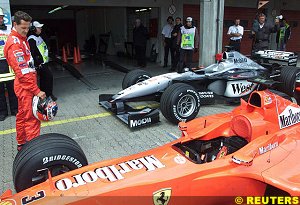| ATLAS F1 Volume 6, Issue 31 | |||
 |
The F1 Rulebook | ||
| by Will Gray, England | |||
|
In a new series of articles, Will Gray delves into Formula One's rulebook and investigates the in-depth documentation that governs Formula One: from rules defining how the event should be run, to those restricting designers and engineers in technical areas
Part 3: The Track
A race weekend is a hectic time, and to install some order to the process, the FIA convey any important information to the teams through the rather non-technological manner of a pin board! The first piece of information on the board is the times and plans for the weekend, along with the names of all the important organisers of the event. From then on, the main information that goes up details the timing from all the sessions, and notification of unusual events (such as disqualifications, protests or withdrawals).
Although we know the starting line up immediately after qualifying, the grid is not published until after the morning warm-up on race day, and teams may still withdraw a car from the race at any time. If they do so within 45 minutes of the start, however, the grid will not be allowed to close up and there will be a space on the grid where the car should have been. The grid is staggered, and drivers risk all for a hot lap in qualifying, just to jump one spot on the grid - yet the gain in distance is just 8 meters! However, even that is enough to make the difference into the first corner. Once the cars head off on the formation lap (which immediately precedes the start) only the privileged or crazy few are allowed onto the track. From then until the final car enters parc ferme at the end of the race, a rule states that firstly, as long as they have permission from a marshall, a driver may drive on the circuit - quite a relief really, that one! He may also walk on the track if given permission, as may the marshalls themselves if they need to remove the aforementioned's stricken car. After those, there is just one more instance where people are allowed onto the track: Although the mechanics are banned from the grid once there is less than one minute to go before the formation lap, if a car fails to set off on that lap, they may return to the grid to assist it.
As drivers head off on the formation lap, most accelerate hard and spin their wheels. Although practice starts are not allowed, this is acceptable, and it leaves rubber on their grid spot which gives more grip for the start. A rule which came to light when Michael Schumacher broke it, was the rule that a driver is not allowed to overtake unnecessarily on the formation lap. It seems an absurd and needless rule, but it is there, and it caught the German out at the British Grand Prix in 1994, leading to first a stop-go penalty, and later, disqualification. To ensure the start is safe for all concerned, only marshals are allowed on pit wall, and all the top team bosses who stand there for the rest of the race are banished to the garages. Once the start is over, the men on pit wall can return to their positions, but there are a number of other rules the whole team must obey throughout the race. Firstly, the team are only allowed into the pit lane on the lap that the car is coming in. This is mainly for safety, but can also provide useful information to the opposition on tactics, and for this reason some teams will stay in the garages until as late as possible before the car comes in. When it does, it must keep to a limit of 60km/h in practice and 80km/h in the race, and if these speeds are exceeded, the driver will be fined US$250 for each km/h he drove over the limit, or be pulled in for a 10-second stop-go penalty during the race. The pitlane is split into a fast lane (closest to the track), and a slow lane (closest to the garage), and once out of the garage, the team may work only in the slow lane, and must leave no equipment in the fast lane. In addition to this, no driver can reverse in the pit lane if he has missed his pit. Nigel Mansell broke the reversing rule in 1990 when he overshot his pit and reversed back into it, while in 1991 he had a tyre changed in the fast lane after a wheel fell off only metres after he had pulled away from a pit stop. Finally, the rules state that 'all animals, except those which may have been expressly authorised by the FIA' are banned from the pit area!
When the crowd invaded the track at Silverstone in 1992, the marshalls were faced with a difficult job. Several of the cars couldn't make it back around to parc ferme, and whilst stopped on the track they were ripped apart by souvenir-hunting fans - in fact, were it not for the stewards' compassion, Nigel Mansell's loyal fans could have got him disqualified from the race! Previous Parts in this Series: Part 1 | Part 2
|
| Will Gray | © 2000 Kaizar.Com, Incorporated. |
| Send comments to: gray@atlasf1.com | Terms & Conditions |


